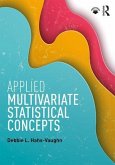Schade – dieser Artikel ist leider ausverkauft. Sobald wir wissen, ob und wann der Artikel wieder verfügbar ist, informieren wir Sie an dieser Stelle.
- Broschiertes Buch
- Merkliste
- Auf die Merkliste
- Bewerten Bewerten
- Teilen
- Produkt teilen
- Produkterinnerung
- Produkterinnerung
This book focuses on the process of preparing raw data for analysis-commonly known as data cleaning. It covers a range of topics including data compilation, variable naming and labeling, data examination, and variable re-coding and transformations, among others. Two example projects and datasets are used to illustrate the methods in the book, and the datasets, script files, and output files in both R and Stata are available to download from the accompanying website.
Andere Kunden interessierten sich auch für
![Security and Risk Technologies in Criminal Justice Security and Risk Technologies in Criminal Justice]() Security and Risk Technologies in Criminal Justice61,99 €
Security and Risk Technologies in Criminal Justice61,99 €![Applied Multivariate Statistical Concepts Applied Multivariate Statistical Concepts]() Debbie L Hahs-VaughnApplied Multivariate Statistical Concepts131,99 €
Debbie L Hahs-VaughnApplied Multivariate Statistical Concepts131,99 €![Research Methods for Criminal Justice and Criminology Research Methods for Criminal Justice and Criminology]() Christine TartaroResearch Methods for Criminal Justice and Criminology59,99 €
Christine TartaroResearch Methods for Criminal Justice and Criminology59,99 €![Diskurs und Macht Diskurs und Macht]() Peter V. ZimaDiskurs und Macht26,90 €
Peter V. ZimaDiskurs und Macht26,90 €![Media/Society Media/Society]() David R CroteauMedia/Society125,99 €
David R CroteauMedia/Society125,99 €![Nationalism Nationalism]() Philip SpencerNationalism74,99 €
Philip SpencerNationalism74,99 €![Classical Sociology Classical Sociology]() Bryan S TurnerClassical Sociology75,99 €
Bryan S TurnerClassical Sociology75,99 €-
-
-
This book focuses on the process of preparing raw data for analysis-commonly known as data cleaning. It covers a range of topics including data compilation, variable naming and labeling, data examination, and variable re-coding and transformations, among others. Two example projects and datasets are used to illustrate the methods in the book, and the datasets, script files, and output files in both R and Stata are available to download from the accompanying website.
Produktdetails
- Produktdetails
- Verlag: Sage Publications Inc Ebooks
- Seitenzahl: 224
- Erscheinungstermin: 13. November 2025
- Englisch
- Abmessung: 215mm x 139mm
- Gewicht: 310g
- ISBN-13: 9781071919569
- ISBN-10: 1071919563
- Artikelnr.: 72653487
- Herstellerkennzeichnung
- Libri GmbH
- Europaallee 1
- 36244 Bad Hersfeld
- gpsr@libri.de
- Verlag: Sage Publications Inc Ebooks
- Seitenzahl: 224
- Erscheinungstermin: 13. November 2025
- Englisch
- Abmessung: 215mm x 139mm
- Gewicht: 310g
- ISBN-13: 9781071919569
- ISBN-10: 1071919563
- Artikelnr.: 72653487
- Herstellerkennzeichnung
- Libri GmbH
- Europaallee 1
- 36244 Bad Hersfeld
- gpsr@libri.de
Bianca Manago is an Assistant Professor of Sociology at Vanderbilt University. She has taught both graduate and undergraduate statistics courses and has also taught workshops on data cleaning and workflow for Statistical Horizons. She received her doctorate in sociology and master's in applied statistics from Indiana University. She also has a master's in sociology and undergraduate degrees in sociology and philosophy from Texas A&M University.
Preface
Acknowledgments
About the Author
Part: 1 Introduction
Chapter 1: Data Preparation: The Need for Strategy and Transparency
Importance of data preparation
Transparency
Tools for transparency
Summary
Chapter 2: Software and Script File Considerations
Software considerations
Script file robustness and legibility
Summary
Chapter 3: File Organization and Naming
Dual workflow and primary script files
File structure and document organization
Naming: files, folders, and more
Summary
Part 2: CLEANR Method
Chapter 4: Introduction
Data preparation steps
Rationale behind the order
Reconsider the rules of ordering
Summary
Chapter 5: Compiling Data
Preparing for data compilation
Collecting data
Downloading data
Steps between downloading data and uploading data
Uploading and importing data
Dropping and keeping variables
Appending and merging data frames
Re-shaping data frames
Summary
Chapter 6: Labeling and Naming Variables and Values
Variable naming
Variable and value labels
Summary
Chapter 7: Examining Data
Data quality indicators
Respondent quality
Characteristics of data sample
Summary
Chapter 8: Addressing Data Problems
Low quality data
Anomalous data
Missing data strategies
Summary
Chapter 9: New Variable Creation
Composite (scale) variables
Standardizing through use of proportions, percents, and rates
Integer/label encoding
Re-coding/discretization
Summary
Chapter 10: Re-configure, Re-examine, and Review
Re-configuring data
Re-examining data
Code review
Summary
Part 3: Review and Conclusion
Chapter 11: CLEANR in practice
General Social Survey
Systematic Review
Summary
Chapter 12: Conclusion
Section I: Best Practices
Section II: CLEANR Method
Section III: Conclusion
Conclusion
References
Acknowledgments
About the Author
Part: 1 Introduction
Chapter 1: Data Preparation: The Need for Strategy and Transparency
Importance of data preparation
Transparency
Tools for transparency
Summary
Chapter 2: Software and Script File Considerations
Software considerations
Script file robustness and legibility
Summary
Chapter 3: File Organization and Naming
Dual workflow and primary script files
File structure and document organization
Naming: files, folders, and more
Summary
Part 2: CLEANR Method
Chapter 4: Introduction
Data preparation steps
Rationale behind the order
Reconsider the rules of ordering
Summary
Chapter 5: Compiling Data
Preparing for data compilation
Collecting data
Downloading data
Steps between downloading data and uploading data
Uploading and importing data
Dropping and keeping variables
Appending and merging data frames
Re-shaping data frames
Summary
Chapter 6: Labeling and Naming Variables and Values
Variable naming
Variable and value labels
Summary
Chapter 7: Examining Data
Data quality indicators
Respondent quality
Characteristics of data sample
Summary
Chapter 8: Addressing Data Problems
Low quality data
Anomalous data
Missing data strategies
Summary
Chapter 9: New Variable Creation
Composite (scale) variables
Standardizing through use of proportions, percents, and rates
Integer/label encoding
Re-coding/discretization
Summary
Chapter 10: Re-configure, Re-examine, and Review
Re-configuring data
Re-examining data
Code review
Summary
Part 3: Review and Conclusion
Chapter 11: CLEANR in practice
General Social Survey
Systematic Review
Summary
Chapter 12: Conclusion
Section I: Best Practices
Section II: CLEANR Method
Section III: Conclusion
Conclusion
References
Preface
Acknowledgments
About the Author
Part: 1 Introduction
Chapter 1: Data Preparation: The Need for Strategy and Transparency
Importance of data preparation
Transparency
Tools for transparency
Summary
Chapter 2: Software and Script File Considerations
Software considerations
Script file robustness and legibility
Summary
Chapter 3: File Organization and Naming
Dual workflow and primary script files
File structure and document organization
Naming: files, folders, and more
Summary
Part 2: CLEANR Method
Chapter 4: Introduction
Data preparation steps
Rationale behind the order
Reconsider the rules of ordering
Summary
Chapter 5: Compiling Data
Preparing for data compilation
Collecting data
Downloading data
Steps between downloading data and uploading data
Uploading and importing data
Dropping and keeping variables
Appending and merging data frames
Re-shaping data frames
Summary
Chapter 6: Labeling and Naming Variables and Values
Variable naming
Variable and value labels
Summary
Chapter 7: Examining Data
Data quality indicators
Respondent quality
Characteristics of data sample
Summary
Chapter 8: Addressing Data Problems
Low quality data
Anomalous data
Missing data strategies
Summary
Chapter 9: New Variable Creation
Composite (scale) variables
Standardizing through use of proportions, percents, and rates
Integer/label encoding
Re-coding/discretization
Summary
Chapter 10: Re-configure, Re-examine, and Review
Re-configuring data
Re-examining data
Code review
Summary
Part 3: Review and Conclusion
Chapter 11: CLEANR in practice
General Social Survey
Systematic Review
Summary
Chapter 12: Conclusion
Section I: Best Practices
Section II: CLEANR Method
Section III: Conclusion
Conclusion
References
Acknowledgments
About the Author
Part: 1 Introduction
Chapter 1: Data Preparation: The Need for Strategy and Transparency
Importance of data preparation
Transparency
Tools for transparency
Summary
Chapter 2: Software and Script File Considerations
Software considerations
Script file robustness and legibility
Summary
Chapter 3: File Organization and Naming
Dual workflow and primary script files
File structure and document organization
Naming: files, folders, and more
Summary
Part 2: CLEANR Method
Chapter 4: Introduction
Data preparation steps
Rationale behind the order
Reconsider the rules of ordering
Summary
Chapter 5: Compiling Data
Preparing for data compilation
Collecting data
Downloading data
Steps between downloading data and uploading data
Uploading and importing data
Dropping and keeping variables
Appending and merging data frames
Re-shaping data frames
Summary
Chapter 6: Labeling and Naming Variables and Values
Variable naming
Variable and value labels
Summary
Chapter 7: Examining Data
Data quality indicators
Respondent quality
Characteristics of data sample
Summary
Chapter 8: Addressing Data Problems
Low quality data
Anomalous data
Missing data strategies
Summary
Chapter 9: New Variable Creation
Composite (scale) variables
Standardizing through use of proportions, percents, and rates
Integer/label encoding
Re-coding/discretization
Summary
Chapter 10: Re-configure, Re-examine, and Review
Re-configuring data
Re-examining data
Code review
Summary
Part 3: Review and Conclusion
Chapter 11: CLEANR in practice
General Social Survey
Systematic Review
Summary
Chapter 12: Conclusion
Section I: Best Practices
Section II: CLEANR Method
Section III: Conclusion
Conclusion
References








